Getting Started with Your CV and Cover Letter

Crafting a strong CV (Curriculum Vititae) and cover letter is the cornerstone of a successful job application. These documents are your first opportunity to make a strong impression on a potential employer. They not only showcase your qualifications and experiences but also reflect your ability to communicate effectively. This section will guide you through the essentials of creating compelling and professional CVs and cover letters.
The Role of Your CV and Cover Letter
Your CV and cover letter are complementary documents. While your CV provides a concise overview of your professional history, the cover letter offers a platform to articulate your interest in the position and how your skills align with the company’s needs.
- CV: This is a detailed account of your professional journey, including your education, employment history, achievements, and skills.
- Cover Letter: This is your chance to connect the dots for the employer, explaining how your experiences make you the ideal candidate for the job.
Importance of Personalization
Each job application is unique, and so should be your CV and cover letter. Tailoring these documents to align with the specific requirements of the job and the company is crucial. This demonstrates your genuine interest in the role and shows that you have taken the time to understand what the employer is looking for.
A Professional First Impression
The presentation of your CV and cover letter matters as much as their content. A well-structured, error-free, and easy-to-read CV and cover letter set a professional tone. Pay attention to the layout, font choice, and overall aesthetics to ensure your documents are pleasing to the eye and easy to navigate.
Upcoming Sections
In the following sections, we will delve deeper into the specifics of crafting effective CVs and cover letters. From outlining the must-have elements of a CV to the art of writing an impactful cover letter, we will guide you through each step of creating documents that will stand out in a competitive job market.
Contents
- The Essentials of a Strong CV
- Tailoring Your CV for Different Roles
- Writing an Impactful Cover Letter
- Common Mistakes to Avoid in CVs and Cover Letters
- Advanced Tips and Techniques
- CV and Cover Letter for Different Career Stages
- Digital and Creative CVs and Cover Letters
- FAQs and Resources
The Essentials of a Strong CV
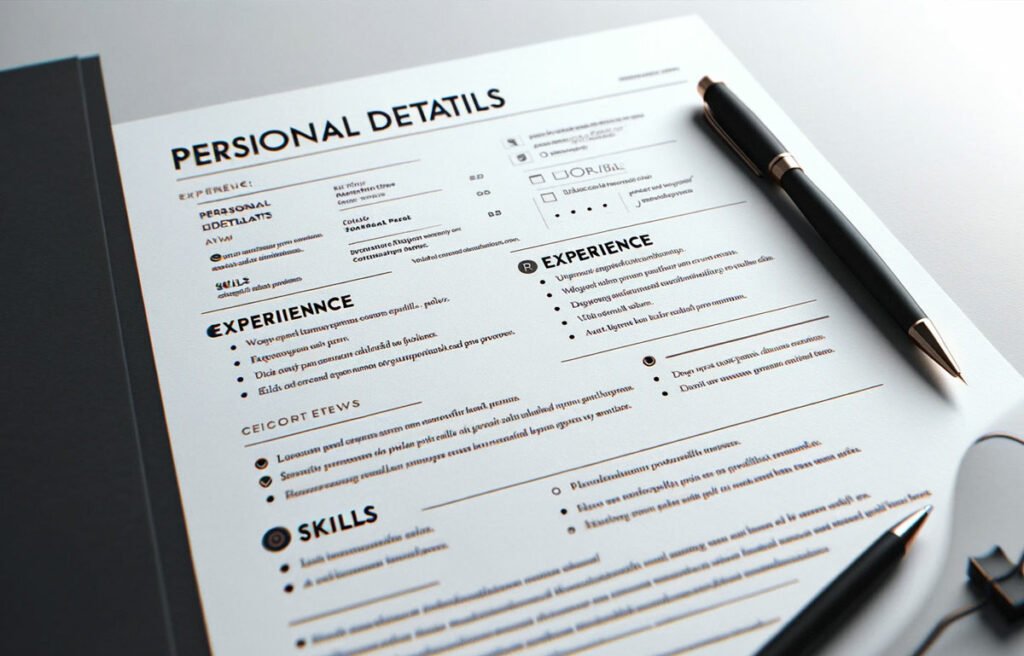
Overview
A well-crafted CV is your passport to an interview. It should effectively communicate your skills, experiences, and achievements in a manner that is both comprehensive and concise. This section outlines the key elements that constitute a strong CV.
Personal Details
Start with your personal details at the top of your CV. This should include:
- Name: Clearly stated and formatted.
- Contact Information: Professional email address and phone number.
- LinkedIn Profile (optional): If relevant and up-to-date.
Professional Experience
This is the core of your CV. Structure it as follows:
- List of Roles: Start with your most recent role and work backwards.
- Responsibilities and Achievements: Use bullet points to detail key responsibilities and accomplishments in each role.
- Quantifiable Achievements: Where possible, use numbers to quantify your achievements.
Education
Include your educational background, focusing on higher education and any relevant qualifications. List:
- Institution Name
- Degree and Major
- Graduation Year (optional)
Skills
Highlight skills relevant to the job you are applying for. This section can include:
- Technical Skills: Specific to your field (e.g., programming languages for a tech role).
- Soft Skills: Communication, teamwork, problem-solving, etc.
Additional Sections (Optional)
Depending on your experience and the role you’re applying for, consider adding:
- Certifications: Relevant professional certifications.
- Languages: If you speak multiple languages.
- Volunteer Work: Especially if relevant to the job.
- Hobbies and Interests: If they can add value to your application.
Formatting and Style
- Consistency: Use the same font and formatting throughout.
- Clarity: Make it easy to read with clear headings and bullet points.
- Length: Aim for two pages, maximum.
Final Tips
- Proofread: Ensure there are no spelling or grammar errors.
- Customise: Tailor your CV for each application, aligning it with the job description.
Tailoring Your CV for Different Roles
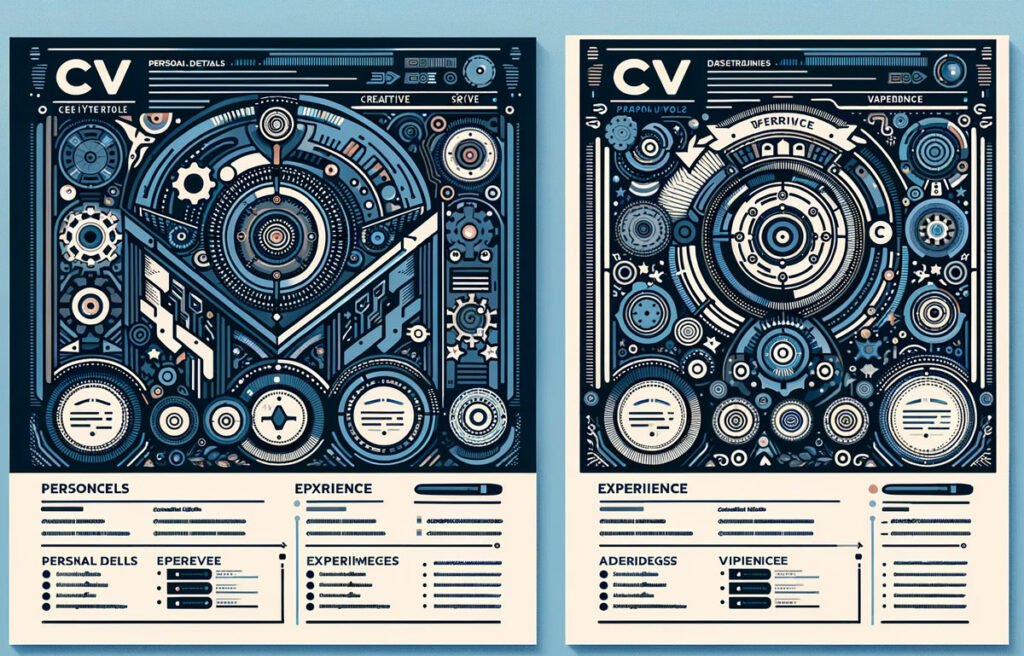
Understanding the Need for Tailoring
One CV does not fit all job applications. Tailoring your CV for each role you apply for is a critical step in showcasing your suitability for that specific position. This approach demonstrates to the employer that you’ve taken the time to understand the role and align your skills and experiences accordingly.
Analysing the Job Description
Start by carefully analysing the job description. Identify the key skills, experiences, and qualifications the employer is looking for. These will be your guideposts for tailoring your CV.
Adjusting Your CV
- Professional Summary: Modify this section to reflect the key attributes sought in the job description.
- Skills: Highlight skills that are most relevant to the role. For technical roles, prioritise technical skills; for creative roles, focus on creative abilities.
- Experience: Emphasise roles and responsibilities from your experience that align with the job requirements.
- Achievements: Where possible, include achievements that demonstrate your proficiency in areas critical to the role.
Balancing Relevance and Completeness
While tailoring your CV, ensure that it remains a complete overview of your professional journey. Do not omit significant experiences or skills; instead, frame them in a way that demonstrates their relevance to the role.
Example: Tailored CVs for Different Roles
To illustrate, consider how a CV might be adapted for a creative role versus a technical role:
- Creative Role: Emphasise design skills, creativity, and experience in creative projects.
- Technical Role: Highlight technical expertise, problem-solving skills, and experience in tech-driven environments.
In the next section, we will explore how to write an impactful cover letter. This document complements your CV and provides an opportunity to articulate your enthusiasm for the role and how your skills and experiences make you the perfect candidate. We will delve into the structure, content, and nuances of crafting a cover letter that resonates with potential employers.
Writing an Impactful Cover Letter
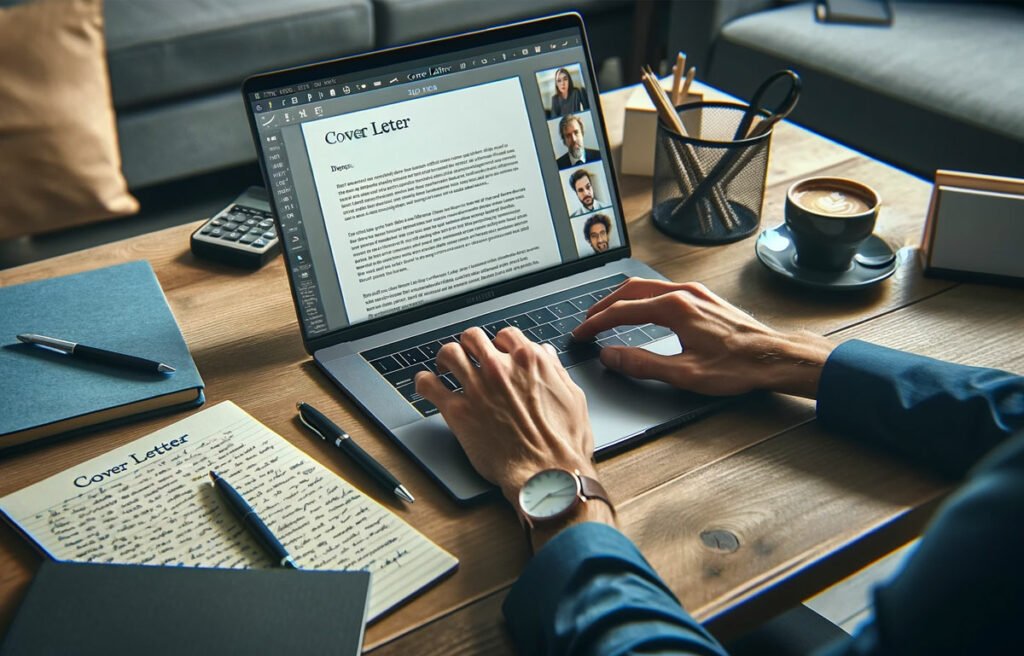
Purpose of a Cover Letter
A cover letter is more than a formality; it’s an opportunity to make a personal connection with the employer and highlight why you are the ideal candidate for the job. It complements your CV by weaving your experiences and skills into a narrative that aligns with the company’s values and needs.
Structure of the Cover Letter
- Introduction: Start with a strong opening that grabs attention. Briefly introduce yourself and state the role you’re applying for.
- Body: In one or two paragraphs, link your skills and experiences to the job description. Use specific examples to demonstrate how your background makes you a great fit for the role.
- Conclusion: Conclude by reiterating your interest in the position and thanking the reader for considering your application.
Personalisation and Research
- Tailor to the Company: Show that you have researched the company and understand its culture and values.
- Address the Hiring Manager: Whenever possible, address the letter to a specific person.
Tone and Content
- Professional yet Personal: Maintain a professional tone while allowing your personality to shine through.
- Clarity and Brevity: Be clear and concise. Your cover letter should typically be no longer than one page.
What to Avoid
- Repetition: Don’t simply repeat what’s on your CV. Instead, provide context and additional insights into your experiences.
- Generic Statements: Avoid generic phrases and focus on specific examples.
Finishing Touches
- Proofread: Ensure there are no spelling or grammar errors.
- Format: Match the formatting of your CV for a cohesive application package.
In the next section, we will identify common pitfalls in preparing CVs and cover letters. Understanding these mistakes is crucial in crafting documents that will stand out positively to potential employers. We’ll provide tips on how to avoid these errors and ensure your application makes the right impression.
Common Mistakes to Avoid in CVs and Cover Letters
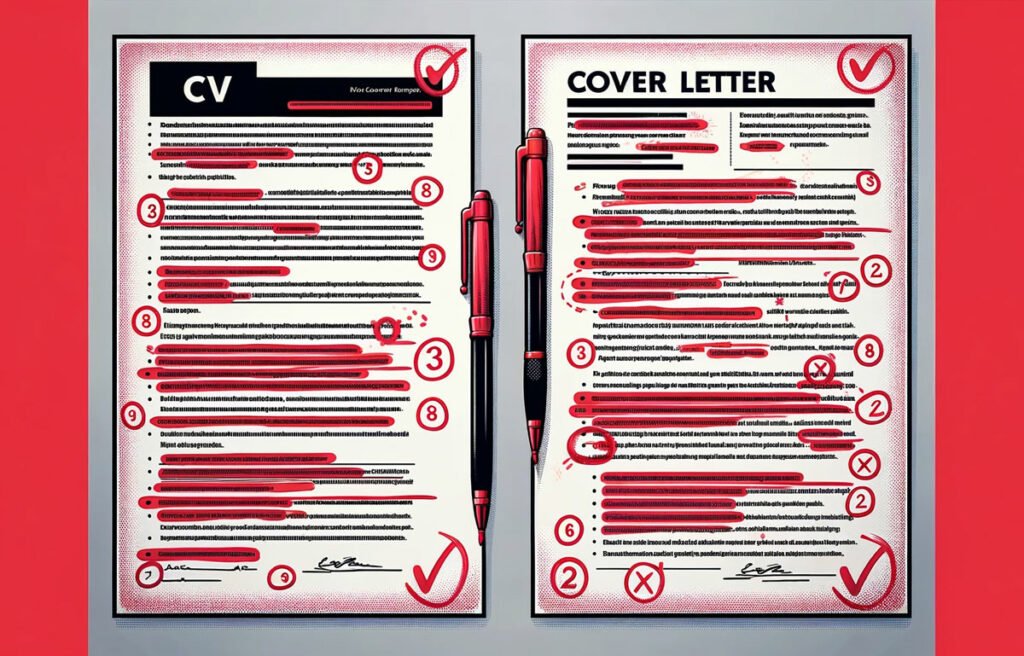
Overview
Even small mistakes in your CV and cover letter can significantly impact your job application’s success. Awareness of common errors and careful proofreading can prevent your application from being overlooked.
CV Mistakes
- Typos and Grammatical Errors: These suggest a lack of attention to detail. Always proofread and consider using grammar checking tools.
- Inconsistent Formatting: Use the same font, size, and style throughout your CV for a professional look.
- Too Long or Too Short: Aim for a 2-page CV. More than that can overwhelm, less might under-represent your experiences.
- Irrelevant Information: Avoid including unrelated work experiences or personal details that don’t add value to your application.
- Lack of Specifics: Quantify achievements and provide specific examples of your skills in action.
Cover Letter Mistakes
- Generic Content: Tailor your cover letter for each job application. Generic letters can come off as insincere.
- Repeating Your CV: Use your cover letter to elaborate on your CV, not just repeat it.
- Focusing Too Much on Yourself: Balance talking about your skills with how you can contribute to the company.
- Neglecting to Explain Gaps: If there are noticeable gaps in your CV, briefly address them in your cover letter.
- Overly Formal or Casual Tone: Maintain a professional tone that matches the company’s culture.
General Tips
- Customise for the Job: Align your CV and cover letter with the job description and company culture.
- Seek Feedback: Have someone else review your CV and cover letter before submitting.
- Be Honest: Avoid exaggerating your experiences or qualifications.
In the following section, we will explore advanced tips and techniques to enhance your CV and cover letter. These insights will help you go beyond the basics, ensuring your application not only avoids common mistakes but also stands out in a competitive job market.
Advanced Tips and Techniques

Elevating Your Application
Once you have mastered the basics of CV and cover letter writing, these advanced tips can help elevate your application to the next level.
CV Enhancement Tips
- Optimising Keywords: Use industry-specific keywords to pass through Applicant Tracking Systems (ATS) and catch the employer’s attention.
- Dynamic Language: Use action verbs to start bullet points, giving your CV energy and clarity.
- Quantifiable Achievements: Wherever possible, quantify your achievements (e.g., ‘Increased sales by 20%’).
- Customised Professional Summary: Tailor this section for each application, highlighting how your skills align with the job.
- Incorporating Testimonials: If you have notable commendations or endorsements, include brief quotes in your CV.
Cover Letter Enhancement Tips
- Telling a Story: Weave your qualifications into a narrative that explains your career journey and why you’re drawn to this role.
- Focusing on the Employer: Discuss how you can solve problems or add value to their team.
- Using a Strong Closing: End with a call to action, such as expressing eagerness to discuss your application in an interview.
- Balance and Aesthetics: Ensure the layout of your cover letter matches your CV for a consistent brand.
General Application Tips
- Digital Readiness: Ensure your CV and cover letter are optimised for both print and digital formats.
- Professional Online Presence: Align your LinkedIn profile with your CV, showcasing a consistent professional image.
- Continuous Improvement: Regularly update your CV and cover letter as you acquire new skills and experiences.
In the next section, we will address how to adapt your CV and cover letter for different stages of your career, whether you’re just starting, at a mid-career level, or a seasoned professional. Tailoring your application to your career stage is key to showcasing your experiences and skills effectively.
CV and Cover Letter for Different Career Stages
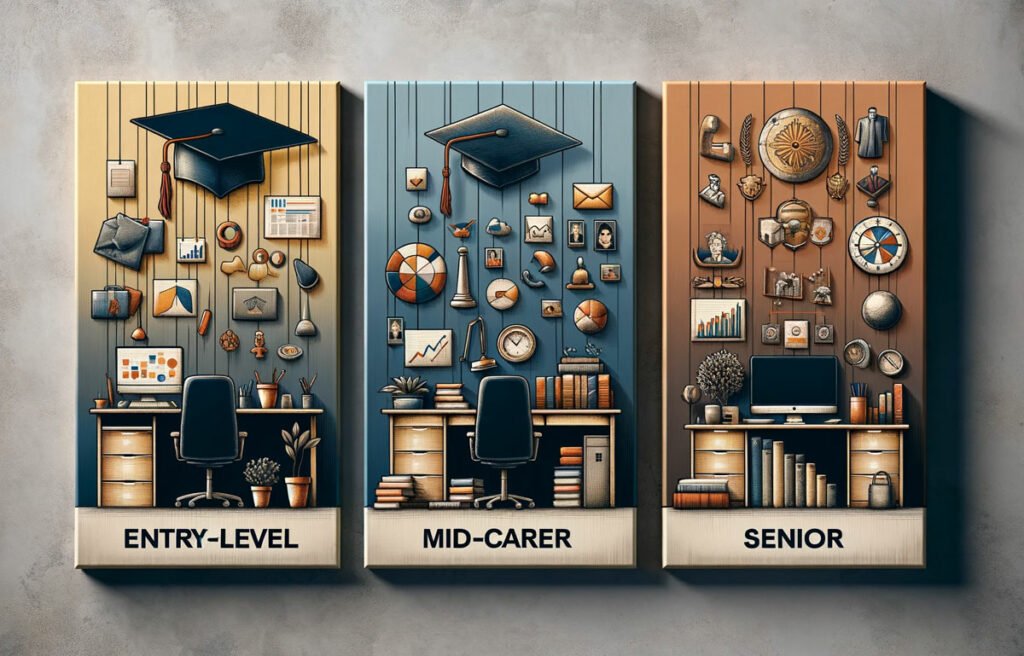
Adapting to Your Career Stage
Your CV and cover letter should evolve with your career. The content and emphasis will differ depending on whether you’re at the entry-level, mid-career, or in a senior position.
Entry-Level
- Highlight Education: Place more emphasis on your academic achievements, especially if you have limited work experience.
- Internships and Projects: Include internships, volunteer work, or academic projects that demonstrate relevant skills.
- Skills and Potential: Focus on transferable skills and your potential to grow.
- Cover Letter: Express your enthusiasm for the field and willingness to learn.
Mid-Career
- Professional Experience: This should be the core of your CV, highlighting achievements in your roles.
- Leadership and Management Skills: If applicable, showcase any experience in leading teams or managing projects.
- Continuous Learning: Include any additional qualifications or training relevant to your career advancement.
- Cover Letter: Demonstrate your expertise in the field and how you can contribute to the company’s growth.
Senior-Level
- Strategic Impact: Emphasise leadership roles and your impact on organisational growth and success.
- Major Achievements: Highlight significant achievements and high-level projects or initiatives you’ve led.
- Thought Leadership: Include publications, speaking engagements, or any industry-specific recognition.
- Cover Letter: Focus on your vision, leadership style, and how your experience aligns with the strategic goals of the organisation.
Consistency Across Stages
- Tailoring: Always tailor your CV and cover letter to the specific role and company you’re applying to, regardless of your career stage.
- Professionalism: Maintain a high standard of professionalism in both documents at all stages.
In the next section, we will explore the growing trend of digital and creative formats for CVs and cover letters. These innovative styles can help you stand out in industries that value creativity and technological savvy.
Digital and Creative CVs and Cover Letters

Embracing Modern Formats
In a digital age, the traditional formats of CVs and cover letters are evolving. Creative and digital formats can help you stand out, especially in industries that value innovation and creativity.
Digital CVs
- Interactive Elements: Include hyperlinks to your professional online profiles, portfolio, or projects.
- Infographics: Use infographics to represent your skills, experiences, and achievements visually.
- Video CVs: A short, professionally made video can add a personal touch and is particularly effective in certain industries.
- Online Portfolios: For creative professionals, an online portfolio can effectively showcase your work.
Creative Cover Letters
- Digital Storytelling: Use multimedia elements like images, links, or even a short video to complement your narrative.
- Interactive PDFs: Create a dynamic PDF with clickable content, allowing employers to interact with your application.
- Design Elements: Employ design principles to make your cover letter visually appealing and reflective of your personality.
Balancing Creativity and Professionalism
- Industry Appropriateness: Ensure that your creative approach aligns with the expectations of your industry.
- Clarity and Conciseness: Even in creative formats, your content should be clear and to the point.
- Accessibility: Make sure your digital and creative documents are accessible and easy to navigate.
Tools and Platforms
- Design Software: Utilise tools like Adobe InDesign for layout and design.
- Online CV Builders: Platforms like Canva offer templates for creative CVs and cover letters.
Advantages
- Standing Out: A well-executed digital or creative CV and cover letter can make you stand out from other candidates.
- Showcasing Skills: These formats can directly showcase your skills in digital literacy or design.
In the next section, we will provide a comprehensive FAQ and Resources segment. This section will address common queries related to CV and cover letter creation and offer additional resources to aid your job application process.
FAQs and Resources

Navigating Your CV and Cover Letter Journey
It’s normal to have questions as you craft your CV and cover letter. This section aims to address some frequently asked questions and guide you to additional resources for further support.
Frequently Asked Questions
- How long should my CV be?
- Ideally, a CV should be two pages. However, this can vary based on career stage and industry.
- Should I include a photo on my CV?
- In the UK, it’s generally advised not to include a photo unless specifically requested.
- How can I make my CV stand out?
- Use a clear layout, tailor it to the job, and highlight key achievements. Consider using infographics or creative formats for roles in creative industries.
- Is a cover letter always necessary?
- While not always required, a cover letter is recommended as it provides an opportunity to further explain your suitability for the role.
- How should I address employment gaps in my CV?
- Briefly explain employment gaps in your cover letter. Be honest but focus on the positives, like skills gained during the gap.
- Can I use the same cover letter for multiple applications?
- It’s essential to tailor your cover letter for each application to address the specific requirements and culture of the company.
- What are some common red flags in CVs and cover letters?
- Common red flags include unexplained gaps in employment, a lack of customisation, and errors in spelling or grammar.
Additional Resources
- Online CV Builders: Websites like CV Maker offer templates and guidance.
- Professional Writing Services: Consider services like TopCV for professional assistance.
- Career Advice Blogs: Platforms like Reed.co.uk offer valuable insights and tips.
- LinkedIn Learning: Provides courses on resume writing and personal branding.
Seeking Further Help
- Career Coaches: For personalised guidance, consider consulting with a career coach.
- Ask-A-Question Feature: Use our website’s chatbot for quick queries or additional information.
